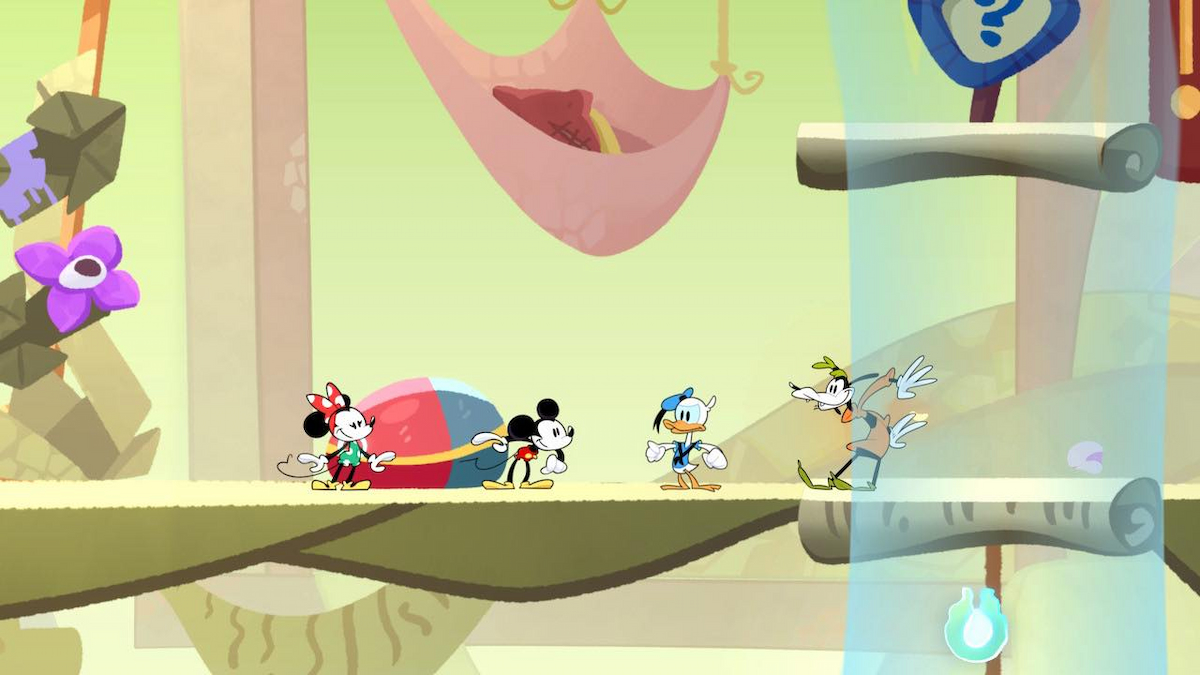When a game like Disney Illusion Island puts “Illusion” in its name, it immediately evokes a rich legacy of Disney platformers.
Growing up, I wasn’t exactly a Disney kid. I had nothing against the mouse’s house, I was just more interested in mascot platformers with tragic backstories. Regardless, I loved the heck out of so many 16-bit Disney platformers. Games like Sega’s Castle of Illusion didn’t engage me because of the license, but because they offered their own unique spin on the world of Mickey Mouse. I still remember how Castle of Illusion could effortlessly transition from feeling whimsical, to mysterious, to kind of ominous when it wanted. Heck, it did all of that in the first world!
To its credit, Disney Illusion Island does not wear the “Illusion” brand lightly. Though it bares little similarity to Sega’s seminal title, I could tell how much the developers at DLALA Studios wanted to create a game that could sit alongside the greats in Disney’s video game canon. In some respects, Illusion Island accomplishes this goal. I just don’t think I’ll reminisce about it 30 years from now.
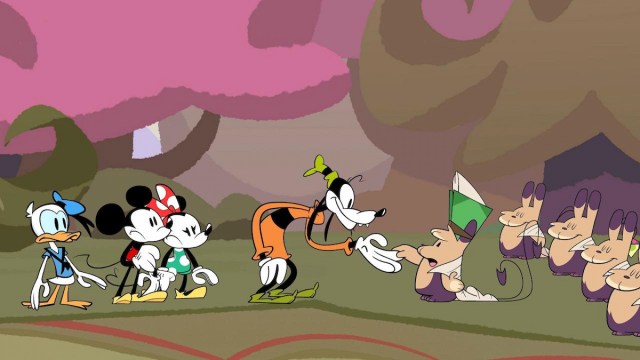
Disney Illusion Island (Switch)
Developer: DLALA Studios, Disney Games
Publisher: Disney Electronic Content
Released: July 28, 2023
MSRP: $39.99
Everybody’s busy bringing you a Disney Afternoon
Illusion Island starts on an unexpected high note. Mickey, Minnie, Donald, and Goofy meet up for a picnic on the titular island, each believing the event was planned by someone else in their crew. But just as many afternoon outings go, the picnic was not planned by friends, but by a race of hamster people who are in desperate need of help. It turns out that calamity is imminent for said hamsters if they don’t collect some magic books, and they need help from heroes who can do the job for them.
Naturally they turn to Mickey and friends to handle that adventuring. And I mean, as someone who grew up playing The Magical Quest Starring Mickey Mouse, I must admit the mouse does have some heroic chops.
As basic as this plot sounds, it’s told in a fully voiced, fully animated scene that I found charming. It has a Disney XD vibe, but I genuinely laughed at some lines here. Unfortunately, outside of the final act of the game, most story bits don’t employ this level of production. You’ll mostly stare at unvoiced dialogue boxes that lean heavier on fourth-wall breaking jokes that just don’t land quite as well, whether you’re a Disney fan or not.
This is a small, arguably inessential disappointment. The story obviously isn’t the focus here, I just liked the fully animated stuff so much that most everything after it felt disappointing. It’s a bummer for younger audiences, but I get the vibe that Illusion Island caters more to Disney adults. Especially when you realize what type of game it is.
Mouse-troidvania
Disney Illusion Island is technically a Metroidvania. If you told me 15 years ago that the exploratory platformer genre would become so popular that Mickey Mouse would throw his hat into the ring, I would have called you crazy. Regardless, here we are. Mickey and friends will traverse interconnected biomes across the island to recover the missing tomes, earning valuable movement upgrades along the way. At the start, the mouse’s party can do little more than run and jump. By the end of the game, they can double jump, wall jump, and even ground pound to access new areas.
Control and movement lay the foundation for any good platformer, and luckily Disney Illusion Island nails this. It doesn’t lock off your best movement options for long, and everything from jump arcs to movement speed feel great. The game lacks any combat mechanics, so a surprisingly nimble move set keeps the experience feeling fresh. I really enjoyed the game when it simply focuses on testing your platforming prowess.
At its best, the level design throws you at challenge rooms that utilize all your abilities. While the game’s hardest is maybe 1/10th of what something like Celeste throws at you, the difficulty can ramp up nicely in the second half. Platforming newbies may choose to play with infinite health, so no one should expect to get stuck necessarily. But as someone who once spent a summer playing Ninja Gaiden to see if I could beat it without any continues, I was shocked that I died in certain sections of the game. Granted, this was mostly due to my own impatience, but more on that in a bit.
While swimming in the latter part of the game can feel a little loose, I felt surprised by how tight Illusion Island controlled. Movement just feels good, with a level of polish typically reserved for top-shelf platformers. This is fortunate, since this counteracts several small stumbles that Illusion Island makes along the way.
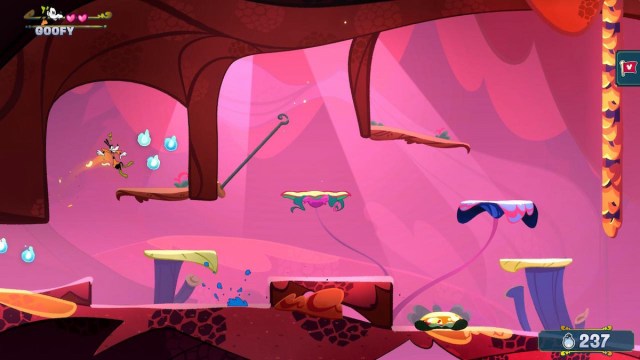
Bouncing here and there and everywhere
The biggest, most substantial question that could not leave my head during the entirety of Illusion Island’s runtime was one I’d never thought I’d ask: why is this a Metroidvania?
Look, I grew up on enough Metroid and Castlevania to absolutely love this genre. I’ve also enjoyed non-violent exploratory platformers too. The thing is, these games only work if they give you incentive to explore, and Illusion Island just… doesn’t have that. Don’t get me wrong, there’s a lot of stuff to collect here. I’d go so far as to call Illusion Island a collect-athon. It’s just that the things you hunt for don’t really matter.
You have Tokuns, a basic compendium of characters and enemies in the game with some banal flavor text. There’s Mickey Memorabilia, which is literally just Disney references drawn by the art team. Hidden Mickeys are, again, just small pieces of art you can find by spotting Mickey Mouse icons in the wild. And finally we have Glimts, the game’s equivalent of coins which unlock health upgrades. While I’m glad something impacts the play experience, these feel relatively insignificant since the game’s difficulty settings already determine how much health you start with.
I don’t think Illusion Island needs a robust RPG system to encourage exploration. But in a game that has precious few fast travel options until criminally late into the game, why would I want to backtrack just to unlock a picture of the wheel from Steamboat Willie? Honestly, that’s all this format really adds to the game: backtracking. Considering you can’t even collect one category of unlockables until you’ve already explored the first few areas, I did occasionally feel that the game was just trying to pad its runtime.
To be clear, I didn’t think the backtracking was necessarily egregious. But I did wish the game would have gone with a simple level-to-level progression instead.
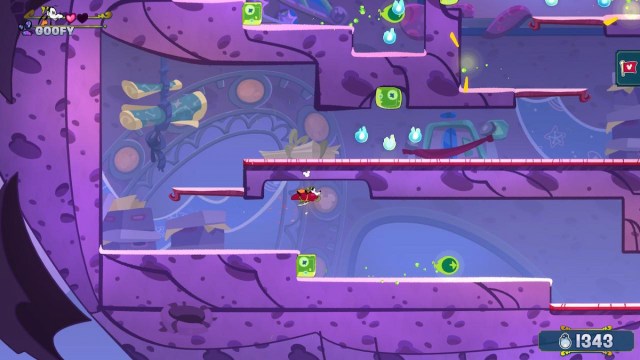
D-d-d-danger! Watch behind you!
I also have to discuss the enemy design, which became more and more of a sticking point as I progressed.
As mentioned above, Illusion Island is a nonviolent platformer. I’m cool with this decision, but you’ll still find plenty of enemies determined to smack you. And without combat, the game’s only way to escalate challenge from enemies involves making you wait. In the late game, I felt an alarming amount of enemies simply existed to interrupt a player’s natural forward trajectory. You can use acrobatics to dodge some foes, but many just want you to wait until they move or finish attacking. No platforming, no strategy, just waiting.
Like the level design, this isn’t game breaking. However, I eventually reached a point where I racked up deaths just because I was tired of waiting for enemies to move and tried to cheese my way past them. Sure, dying over and over to restart at the frequent checkpoints isn’t an efficient way to progress. But I’d rather die on my own terms than let Walt Disney’s grunts control how I live.
After a certain point, I felt Illusion Island wasn’t necessarily getting harder as much as it was making it easier to get hit. I’m sure if I didn’t play on the hardest difficulty setting, I probably could brute force through all these obstacles. I just would have liked to have seen more exploration of the core controls over abrasive enemy placement. The developers put all this work into making movement fun, so why would they want players to not move?
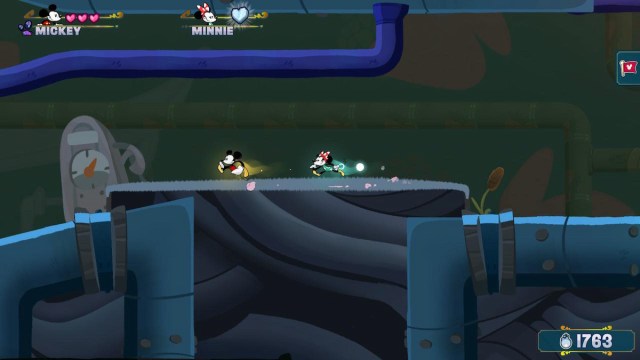
Side by side wherever we go
I do want to touch on the multiplayer in Illusion Island. While major platforming series like Rayman and Super Mario have embraced local multiplayer, I was still excited to test out how it handles here.
I had my girlfriend join my nearly complete playthrough for a session, and the results surprised me. Though she’s generally unfamiliar with 2D platformers, she was able to wall jump and rope swing at my pace within minutes. This really is a testament to how natural Illusion Island feels to play, and we had a lot of fun running around together.
The problem, again, is that I don’t know why this is an exploratory platformer. While I don’t think anything of frequently opening and closing my map to track where I’m going, that constant pausing really disrupts multiplayer. Illusion Island doesn’t have a mini-map either, so even small forks in the road feel more troublesome than necessary. I mean, at several points in the game, you’ll find several branching paths. But three paths will lead to keys, all of which you’ll need to unlock a door blocking the critical path. Our takeaway joke while we played was “in Illusion Island, the only illusion is that we have any freedom.”
I did like that each player could specify their own difficulty level via the health they start with. It makes Illusion Island easy to play with less experienced players when they can just turn on infinite health for themselves. But beyond that, I don’t think Illusion Island stands out as a multiplayer experience unless you specifically want to get someone into platformers. My partner and I enjoyed our session, but we didn’t talk about it after we put our controllers down. And that kind of sums up the game in general.
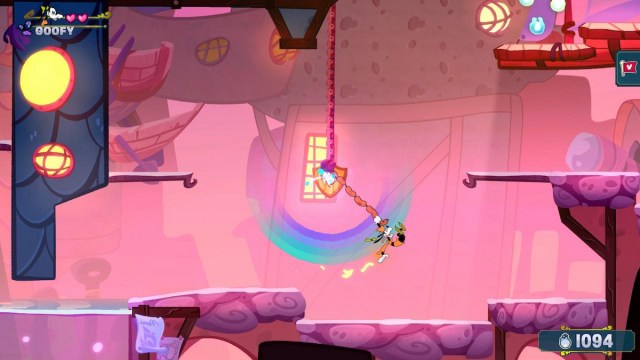
I’m Timothy Monbleau from Destructoid, and you’re reading a Disney review
As much as I’ve focused on nitpicks, I could overlook them all if Illusion Island offered a charming, unique experience like the 16-bit Disney classics. But outside those fun animated scenes, I never saw anything in the game that really stuck with me. All the biomes in the game just kind of blur together, with somewhat differentiated but ultimately unremarkable visuals separating them. Outside of a water zone, the whole thing just feels like one long level.
Yet despite everything, I still played Illusion Island to 100% completion (which took me just under ten hours). And even after I was left with one small incentive to replay the game, I started a second save file. Illusion Island is undoubtedly a fun game. It plays very well at its core, which is hard for me to wax poetic about. But the game does deliver on that, especially when its level design lets those core mechanics shine.
I’d compare my experience to getting a burger from a nice fast casual restaurant. It’s not the best you’ve had, but it’s good in a pinch and you’re glad you had it. And sometimes you need a diversion to entertain you and possibly a family member for a weekend.
Disney Illusion Island won’t go down in history like the best Disney platformer classics have. But it’s still a fun, if not forgettable, romp starring Mickey and friends. Those who are newer to platformers or want to get someone in on the genre will be primed to enjoy this title. Also, while I don’t think the exploratory angle does the game any favors, it may appeal to collect-athon fans. Otherwise, Illusion Island is just a reliable game for a rainy day. A perfect seven if there ever was one.
[This review is based on a retail build of the game provided by the publisher.]
